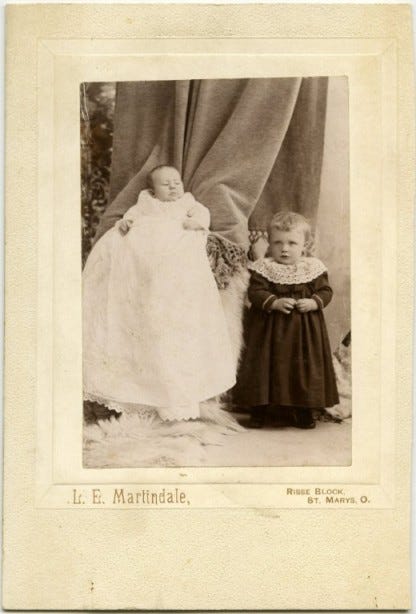The Hidden Women of the Victorian Era
on Victorian photography and the struggle for women's recognition present-day
Last Mother’s Day, I came across a peculiar article about Victorian era photography. This is not usually the type of article I would click on, but because the main title was Invisible Women, it drew my attention into clicking on the article. The article presented me with the concept of photographs with hidden mothers. This article led me down a rabbit hole on these unsettling images. Since then, I have continuously thought about the images and the present-day implications of them.
So, during the 19th century, it was difficult to take pictures of squirmy children due to long exposure times. This led to the need for mothers (from my understanding, it was oftentimes mothers; however, there were examples of the hidden figure being the father or other caregiver, such as a nanny) to keep their babies still for the picture. Mothers were hidden in frame in disguise to get the perfect shot. Sometimes the women were on the sides of the photo, where viewers could only see a hand or arm, so that they could be cropped out later.

I think these images are an interesting way of exposing motherhood, and women’s caregiving roles in general, for what it is—the responsibility of holding everyone else up while being concealed to the back. The women were responsible for helping to create a perfect documentation of the child, yet they get a sheet thrown over their head and body. I mean, would it have been so awful for the picture to be of mother mother and baby? Why not highlight the newly growing relationships between mother and child? Additionally, in photographs where the cloaked woman is a Black woman or woman of color, this is a representation of hiding the caregiving load that BIWOC especially take on historically and presently.
These images of women also highlight another metaphor of caregiving and motherhood, which is that women become ghosts of themselves once they become mothers. I think we can all agree that those who make the choice to become parents have taken an oath to become selfless, as the focus is no longer on the adults, but the child. It’s not really about what the mother wants or needs, especially if it interferes with the children. I fully reject this notion, by the way, I believe that there needs to be a balance in care for children and parent (especially mothers), but society still has its biases about parenthood. However, this leads to the social identity of Mother outdoing all of the other identities of a woman. We often see mothers as one dimensional, they are just mothers. The women in these photos are unknown. We do not know who they were or what they cared about, we just see them as an extension of their child.

A common criticism of pieces that examine these photographs is that us authors are looking too deeply into the picture and the photographer just wanted the picture of the baby. Maybe this is true. Maybe their is nothing to look into in these images. If anything, it’s an interesting (and mildly creepy) dinner conversation that you can share the next time you need to bring a fun historical fact to a social event. However, at most, the veiling of the women in these photos reveals historical ideology about women and mother’s roles and the (lack of) publicization of domestic caregiving.
I really dislike the notion that people are “looking too deeply” into things, especially when it relates to documented history. We should be asking questions. We should be curious. I want to understand this phenomenon, which in my eyes is demeaning. I think about this in a modern day context, if I was getting my picture taken with my hypothetical child and the photographer asked me to put my baby on my lap, hold them still, and put a cloak over my head, I would be befuddled and offended.
Anyways, I’ll always remember these images, they are kind of unforgettable once you see them. Maybe the things these images represent to me, don’t represent the same to you. So, let me know what you make of these images.
That’s it for now. Love u!
Further Readings:
Aiken, D. (n.d.). Family and social rituals. British Literature Wiki. https://sites.udel.edu/britlitwiki/family-social-rituals/#Middlemarch:%20Family%20&%20Social%20Rituals--The%20Victorian%20Family
Cheng, A. Y. & Barnett, E. (2020). Victorian mothers hid themselves in their babies’ photos. The Atlantic. https://www.theatlantic.com/family/archive/2020/05/victorian-mothers-hidden-photos-their-babies/611347/
Cook, S. E. (2013). Images of Victorian motherhood, effaced and exposed. Susan Elizabeth Cook (Blog). https://susanelizabethcook.com/2013/09/12/images-of-victorian-motherhood-effaced-and-exposed/
Edelman, S. (2022). Hidden mother photography. Family Secrets: Uncovering Identity in 19th Century America. https://courses.lsa.umich.edu/familysecrets/hidden-mother-photograph/
Nichols, C. (2012). Hidden mothers in Victorian portraits. The Museum of Ridicuously Interesting Things. https://ridiculouslyinteresting.com/2012/01/05/hidden-mothers-in-victorian-portraits/
Tange, A. K. (2021). Victorian hidden mothers and the continued erasure of mothering. Psyche. https://psyche.co/ideas/victorian-hidden-mothers-and-the-continued-erasure-of-mothering
Whittet, E. O. (2024). Invisible women: On the Victorian custom of cutting mothers out of portraits. Literary Hub. https://lithub.com/invisible-women-on-the-victorian-custom-of-cutting-mothers-out-of-portraits/
Wiki Contributors. (Last updated: 3 November 2024). Hidden mother photography. Wikipedia. https://en.wikipedia.org/wiki/Hidden_mother_photography





